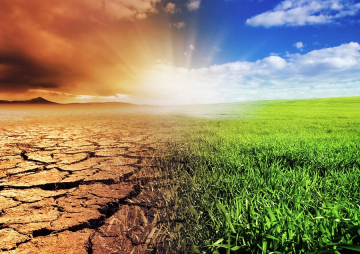In its latest report, the Intergovernmental Panel on Climate Change (IPCC) highlights the increasingly urgent risks confronting the globe as impacts from climate change mount. While the human devastation from COVID-19 and the war in Ukraine are on everyone’s mind, climate change is increasingly impacting our supply chains, food systems, and daily life; the impacts cannot be ignored.
“This report recognizes the interdependence of climate, biodiversity, and people and integrates natural, social, and economic sciences more strongly than earlier IPCC assessments,” said Hoesung Lee, Chair of the IPCC. “It emphasizes the urgency of immediate and more ambitious action to address climate risks. Half measures are no longer an option.”
Luckily, the business community is taking significant action to mitigate its effects on climate change by committing to Science Based and net-zero targets for greenhouse gas emissions as well as preparing facilities, supply chains, and employees for a more uncertain world.
That said, much more needs to be done.
The time to act is now. Reach out to our Climate Change and Sustainability experts today to help prepare your business for the climate-related challenges ahead.
Preparing Your Business for Climate Change
As indicated by the latest IPCC report, impacts of climate change to people, businesses, and communities are inevitable. The first, and perhaps most important, step your business can take to prepare for these impacts is to understand your climate-related risks.
There are two types of climate-related risk: the first is the actual physical risks associated with climate change that we already see manifesting today. Physical risks include both acute and chronic:
- Chronic Physical Risks: These risks compound over time and introduce long-term stress to physical assets. Some examples include sea-level rise, water scarcity, and long-term temperature shifts.
- Acute Physical Risks: These risks are one-time events or “shocks” that have an immediate impact and are difficult to predict. Examples include wildfires, extreme rainstorms, heat waves, and cold snaps.
The other climate related risks are called transition risks: is the financial and social risks associated with regulatory and market changes as governments and individuals pressure businesses to reduce emissions. These risks include:
- Regulatory Transition Risks: This includes government regulations limiting greenhouse gas emissions, such as net-zero targets, cap and trade regimes, and carbon pricing, and can also include litigation risk.
- Market Transition Risks: These risks include investor and consumer pressure to reduce emissions and produce climate-friendly products.
Larry Fink, chairman and CEO of BlackRock, has argued that climate risk is business risk: if a company doesn’t understand its climate-related risks and opportunities, the business as a whole will suffer. So now that you’ve identified your potential risks, how do you take this information and turn it into meaningful action?
Background on TCFD
The Task Force on Climate Related Financial Disclosures (TCFD) provides a useful framework for companies to generate comparable disclosures about how they are assessing and managing climate-related risks. TCFD guides the assessment of a company’s emissions reduction strategy as well as the plans and programs to build climate resiliency. TCFD disclosures should be built on a solid basis of analysis:
- What physical risks do your facilities face from climate-related factors? How will these risks change over time? How is your company managing these risks?
- How are regulations and market expectations lining up against your company’s greenhouse gas reduction strategies and participation in low carbon solutions/development of low carbon products?
- How resilient is your business to a changing physical world?
For a more in-depth look at TCFD, check out our webinar, Getting a Handle on Climate-Related Risks and Opportunities through TCFD which explains TCFD and provides actionable insights for businesses.
What’s Next? Going the extra mile and engaging your communities
A robust risk analysis is a good first step; but the harder step involves taking action and building a more resilient business. Resiliency cannot be built alone; facilities are not islands, and efforts to decarbonize and strengthen infrastructure involve coalitions of community partners and other businesses. To that point, we recommend building capacity by doing the following:
- Develop a Climate Resiliency Toolkit: Having a toolkit for your facilities that lays out mitigation options based on exposure to physical risks. Mitigation options might include:
- Operational measures to better prepare for extreme weather and other events, such as emergency action plans, trainings, and resources
- Capital measures to harden your facilities, such as wet and dry floodproofing strategies, redundant electric power and water systems, and protection/elevation of critical equipment
- Community engagement measures to drive resiliency beyond the facility’s walls, such as funding partnerships for stormwater management solutions, mutual aid agreements, and heat mitigation partnerships.
- Engage With Your Communities: Fighting climate change is an all-hands-on-deck operation. Building robust engagement with communities to ensure that shared infrastructure is being designed to reduce future risk. Who are the key officials within your community that are planning for climate change? How can your business help communities prepare for disruptions?
- Utilize Science Based Targets: Ensuring that the organization’s decarbonization strategy is in line with the latest climate science, by submitting and validating targets through the Science Based Targets Initiative. Science Based Targets (SBT) can be incredibly useful for creating a roadmap for your climate action plan. Setting SBTs helps to shift the decision-making process within a business and lead to long-term, meaningful change.
In conclusion, all businesses should be developing a good understanding of where their climate-related risks lie across their physical footprint. We recommend pairing this analysis with a robust toolkit of actions that facility managers can implement. Further, we recommend starting conversations with community officials and peer businesses to explore opportunities for collective action.
To refer back to the IPCC report, “... tackling all these different challenges involves everyone – governments, the private sector, civil society – working together to prioritize risk reduction, as well as equity and justice, in decision-making and investment,” said IPCC Working Group II Co-Chair Debra Roberts.
Climate change is the challenge of our age, and businesses that pull together and lead will be poised for success in the future.
Want more news and insights like this?
Sign up for our monthly e-newsletter, The New Leaf. Our goal is to keep you updated, educated, and even a bit entertained as it relates to all things EHS and sustainability.
Get e-NewsletterHave any questions?
Contact us to discuss your environment, health, safety, and sustainability needs today.







